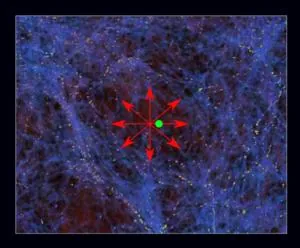
Could Earth Be Sitting in a Cosmic Void? New Research Tackles the Hubble Tension
2025-07-08
Author: Amelia
A New Cosmic Theory Emerges
Imagine our Earth and the entire Milky Way galaxy trapped inside a colossal void—a region where the cosmic expansion outpaces that of surrounding spaces. Astrophysicists are proposing this bold theory as a potential explanation for the perplexing phenomenon known as 'Hubble tension'.
What is Hubble Tension?
The 'Hubble tension' describes the unsettling disparity between the rate of the universe's expansion as observed from distant galaxies and those closer to home. Initially identified by Edwin Hubble in 1929, this concept now raises questions about the universe's true age, estimated at about 13.8 billion years.
Sound Waves from the Big Bang
Recent research unveiled at the Royal Astronomical Society’s National Astronomy Meeting (NAM) hints that primordial sound waves—essentially the "sound of the Big Bang"—may bolster this intriguing void hypothesis. According to Dr. Indranil Banik from the University of Portsmouth, being near the center of a significant void would cause gravitational forces to draw matter toward denser areas, escalating the velocity of objects moving away from Earth.
Unpacking the Local Void Theory
In their theory, scientists propose that to validate this local void model, Earth and our solar system are positioned near the center of a void measuring roughly a billion light-years across, with density around 20% lower than the universe's average. Observational evidence supports this theory: the number of galaxies in our vicinity is notably fewer than in surrounding areas.
Controversy and Challenges
However, not everyone is on board with this hypothesis. Critics argue that such a large void contradicts conventional cosmological models, which suggest a uniform distribution of matter on vast scales. Yet, Dr. Banik’s findings presented at NAM 2025 suggest that the behavior of baryon acoustic oscillations—the aforementioned sound waves—aligns with the void theory. These oscillations have been crucial in charting the universe's expansion.
Next Steps for Research
To validate the local void concept further, researchers aim to compare it with alternative tools like cosmic chronometers, which analyze aging galaxies whose star formation has ceased. By studying the light spectra of these galaxies, they can deduce their ages. This information, along with redshift data, reveals crucial insights into the universe's expansion history.
Conclusion: A Cosmic Mystery Awaits
As scientists delve deeper into the mysteries of the universe, the question remains: Could Earth really be dwelling in the heart of a cosmic void? The coming years promise more exciting discoveries that may reshape our understanding of the cosmos.









 Brasil (PT)
Brasil (PT)
 Canada (EN)
Canada (EN)
 Chile (ES)
Chile (ES)
 Česko (CS)
Česko (CS)
 대한민국 (KO)
대한민국 (KO)
 España (ES)
España (ES)
 France (FR)
France (FR)
 Hong Kong (EN)
Hong Kong (EN)
 Italia (IT)
Italia (IT)
 日本 (JA)
日本 (JA)
 Magyarország (HU)
Magyarország (HU)
 Norge (NO)
Norge (NO)
 Polska (PL)
Polska (PL)
 Schweiz (DE)
Schweiz (DE)
 Singapore (EN)
Singapore (EN)
 Sverige (SV)
Sverige (SV)
 Suomi (FI)
Suomi (FI)
 Türkiye (TR)
Türkiye (TR)
 الإمارات العربية المتحدة (AR)
الإمارات العربية المتحدة (AR)